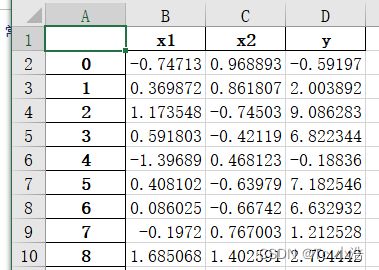机器学习-线性回归(从零实现以及简化实现)
文章目录
- 1、数据集的准备
- 2、保存到excel文件中
- 3、读取数据
- 4、初始化模型参数
- 5、定义模型
- 6、定义损失函数
- 7、定义优化算法
- 8、训练
1、数据集的准备
如果有数据集,则跳过
生成一个包含1000个样本的数据集, 每个样本包含从标准正态分布中采样的2个特征 torch.normal(mean, std, size)
定义一个生成数据样本的函数
def get_data(w,b,num_examples):
#使用正太分布均差为0,方差为1,生成大小(1000,2)
X=torch.normal(0,1,(num_examples,len(w)))
#矩阵相乘
y=torch.matmul(X,w)+b
#加上误差
y+=torch.normal(0,0.01,y.shape)
return X,y.reshape((-1,1))
#我们使用给定的w和b生成数据
#我们使用两个特征,要两个权重w
true_w=torch.tensor([2,-3.4])
true_b=4.2
features,labels=get_data(true_w,true_b,1000)
#把生成的数据拼接起来
features_labels=torch.cat([features,labels],dim=1)
2、保存到excel文件中
数据生成的为tensor数据类型,保存到excel文件中,要转换格式为numpy类型。
import numpy as np
import pandas as pd
# define a as the numpy array
data_excel = features_labels.numpy()
# transform a to pandas DataFrame
a_pd = pd.DataFrame(data_excel ,columns=['x1','x2','y'])
# create writer to write an excel file
writer = pd.ExcelWriter('a.xlsx')
# write in ro file, 'sheet1' is the page title, float_format is the accuracy of data
a_pd.to_excel(writer, 'sheet1', float_format='%.6f')
# save file
writer.save()
3、读取数据
读取文件的numpy数据格式
readbook = pd.read_excel(f'datas.xlsx', engine='openpyxl')
nplist = readbook.to_numpy()
data = nplist[0:]
data = np.float64(data)
#读取前两列
features_x=data[:,[0,1]]
#最后一列
target = data[:,[-1]]
#numpy转Tensor
features=torch.as_tensor(features,dtype=torch.float)
target=torch.as_tensor(target,dtype=float)
4、初始化模型参数
初始化模型参数,通过从均值为0、标准差为0.01的正态分布中采样随机数来初始化权重, 并将偏置初始化为0。
w=torch.normal(0,0.01,(2,1),requires_grad=True)
b=torch.zeros(1,requires_grad=True)
5、定义模型
y = W T X + b y=W^TX+b y=WTX+b
def liner(X,w,b):
return torch.matmul(X,w)+b
6、定义损失函数
因为需要计算损失函数的梯度,所以我们应该先定义损失函数。
def loss(y_hat, y): #@save
"""均方损失"""
return (y_hat - y.reshape(y_hat.shape)) ** 2 / 2
7、定义优化算法
在每一步中,使用从数据集中随机抽取的一个小批量,然后根据参数计算损失的梯度。 接下来,朝着减少损失的方向更新我们的参数。 下面的函数实现小批量随机梯度下降更新。 该函数接受模型参数集合、学习速率和批量大小作为输入。每 一步更新的大小由学习速率lr决定。 因为我们计算的损失是一个批量样本的总和,所以我们用批量大小(batch_size) 来规范化步长,这样步长大小就不会取决于我们对批量大小的选择。
def sgd(params,lr,batch_size):
#小批量随机梯度下降
#使用with torch.no_grad():表明当前计算不需要反向传播,使用之后,强制后边的内容不进行计算图的构建
with torch.no_grad():
for param in params:
param-=lr*param.grad/batch_size
param.grad.zero_()
8、训练
lr = 0.03
num_epochs = 3
net = liner
loss = loss
for epoch in range(num_epochs):
for X, y in data_iter(batch_size, features, labels):
l = loss(net(X, w, b), y) # X和y的小批量损失
# 因为l形状是(batch_size,1),而不是一个标量。l中的所有元素被加到一起,
# 并以此计算关于[w,b]的梯度
l.sum().backward()
sgd([w, b], lr, batch_size) # 使用参数的梯度更新参数
with torch.no_grad():
train_l = loss(net(features, w, b), labels)
print(f'epoch {epoch + 1}, loss {float(train_l.mean()):f}')
#结果
epoch 1, loss 0.030909
epoch 2, loss 0.000110
epoch 3, loss 0.000053
epoch 4, loss 0.000053
epoch 5, loss 0.000053
因此我们通过训练得到了权重w和b
#输入特征进行预测
y_pred=torch.matmul(torch.tensor([[-0.74713,0.968893]]),w)+b
y_true=-59197
y_pred.item()=-0.5895
